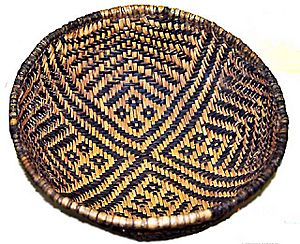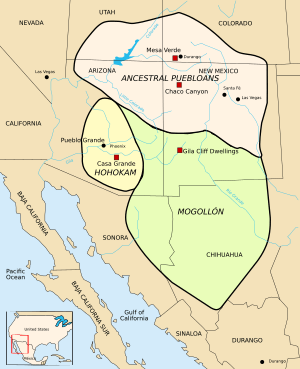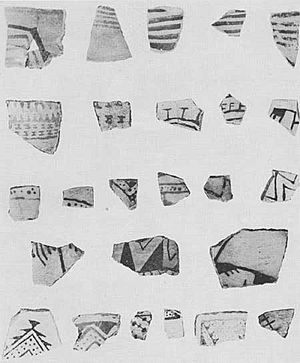Basketmaker III Era facts for kids
The Basketmaker III Era (around 500 to 750 AD) was an important time for the Ancestral Puebloans, also known as the Ancient Pueblo People. During this period, they became better at growing their own food. They also started making pottery and lived in more organized groups of pit-houses. Hunting became easier because they began using the bow and arrow.
This era came after the Late Basketmaker II Era and before the Pueblo I Era.
Contents
Homes and Architecture
During the Basketmaker III Era, people continued to live in pit-houses. However, these homes became much better designed. They were larger and had different sections inside. Each house featured a big central fireplace and a special entrance area called a vestibule. Stone slabs were often used to line the walls, making them stronger.
Most pit-houses were built out in the open, often on top of flat-topped hills called mesas. To build one, people dug a hole several feet deep. This hole was usually between 8 to 20 feet (2.4 to 6.1 m) wide. A wooden frame supported the side walls and roof. This frame was then covered with woven reeds, grass, and finally, mud to protect against the weather. In the middle of the roof, there was an opening. This opening served as a way for fresh air to come in and also as the main entrance to the home. Some pit-houses even had an extra room attached for storage.
Communities and Villages
Life at Mesa Verde
At Mesa Verde, the Basketmaker III people built small groups of pit-houses. These homes were often located on the flat tops of mesas.
Chaco Canyon Settlements
From about 450 to 700 AD, more than 200 Basketmaker sites were found in Chaco Canyon. These sites were on mesas, ridges, and the canyon floor. Each site had clusters of 1 to 20 pit-houses.
One important village was Shabik'eschee, which existed from about 550 to 700 AD. It was much larger than most settlements of the time. Shabik'eschee had 18 pit-houses, which could have housed about 77 people. It also had over 50 storage pits and a very large pit-house. This big pit-house was likely used for important gatherings and ceremonies, similar to a "great" kiva. Most other settlements only had enough space for 5 to 15 people. The many extra storage pits at Shabik'eschee suggest that people from nearby areas might have visited this village often.
Safety in Pleasant View, Colorado
In the area near Pleasant View, Colorado, there might have been a need for communities to protect themselves. At least 11 sites, dating from 600 to 700 AD, show Stockades built around pit-houses. These fences could have been for keeping children safe or for holding domesticated dogs and turkeys. However, many burnt artifacts found at these sites suggest the fences were more likely for defense. One idea is that other local groups might have felt pushed out by the growing number of new Basketmaker III settlements, leading to conflicts.
Culture and Daily Life
During this time, the social and political rules were probably quite relaxed. Important decisions were likely made by the heads of families, who would talk things over and agree together.
Art and Symbols
People also created petroglyphs, which are carvings on rocks. These carvings showed pictures of people and animals. Many of these ancient artworks can be seen in the Petrified Forest National Park.
Farming and Food
The Basketmaker III people were skilled farmers. They grew important crops like beans, squash, and maize (corn). They also started raising turkeys, using them for both their feathers and as a source of food.
Food was stored in special underground pits called cists. These pits were lined and covered with stone to keep the food safe. Besides farming, people also hunted animals, set traps, and gathered wild nuts, plants, and fruits from their environment.
Pottery Making
A big change in the Basketmaker III era was the introduction of pottery. This meant people didn't need to make as many baskets or woven bags. Simple, gray pottery was much better for cooking, storing food, and carrying water.
In the Petrified Forest National Park area, people made a type of pottery called Adamana Brown. This is thought to be the earliest pottery made on the Colorado Plateau.
Tools and Goods
The Basketmaker people became even better at making baskets and weaving during this period. They created many useful items, including bags, baskets, sandals, sashes, and other woven goods. Some baskets were lined with pitch (a sticky tree sap) to hold water. Hot stones were then placed in these water-filled baskets to cook food.
The bow and arrow made hunting much easier. This meant people could get more animal hides for making clothes. While bows and arrows were popular, spears and darts were still used, but less often. Turkey feathers were woven into warm blankets and robes. Babies were carried in soft, comfortable cradle boards that didn't change their head shape.
Other common items from this time included:
- Sandals and rope woven from Yucca plants.
- Stone axes, knives, and other tools for pounding, scraping, and cutting.
- Stone metates (flat grinding stones) and manos (hand stones) used to grind corn into flour.
- Bones used as stitching awls (for poking holes) and scrapers.
- Nets and snares for trapping small animals.
- Digging sticks used to plant seeds in the ground.
- Cradleboards made from yucca, twigs, and rabbit fur.
Cultural Groups and Periods
The main cultural groups during this period included:
- Ancestral Puebloans – found in southern Utah, southern Colorado, northern Arizona, and northern and central New Mexico.
- Hohokam – located in southern Arizona.
- Mogollon – found in southeastern Arizona, southern New Mexico, and northern Mexico.
- Patayan – lived in western Arizona, California, and Baja California.
Important Basketmaker III Sites
Some notable places where Basketmaker III settlements have been found include:
- Chaco Culture National Historical Park – New Mexico
- Darkmold Site – Colorado
- Durango Rock Shelters Archeology Site – Colorado
- Grand Staircase-Escalante National Monument – Utah
- Grand Canyon area – Arizona
- Hovenweep National Monument – Colorado
- Kanab Creek area – Utah and Arizona
- Mesa Verde National Park – Colorado
- Petrified Forest National Park – Arizona
- Spring Creek Archeological District – Colorado
- Talus Village – Colorado
- Virgin Anasazi – in the Colorado Plateau areas of Nevada, Utah, and Arizona
Images for kids









